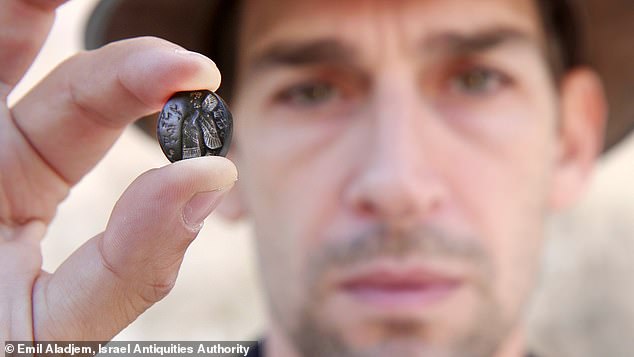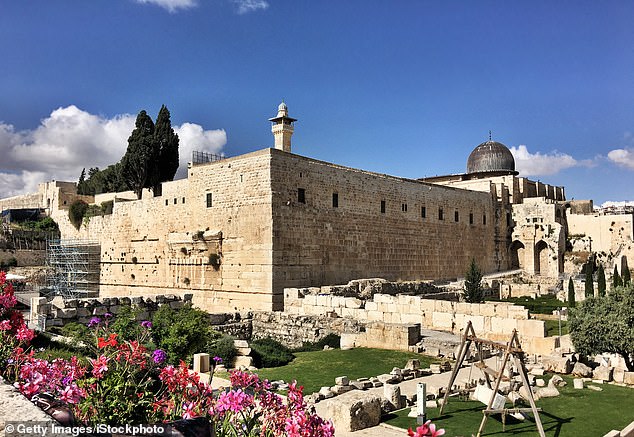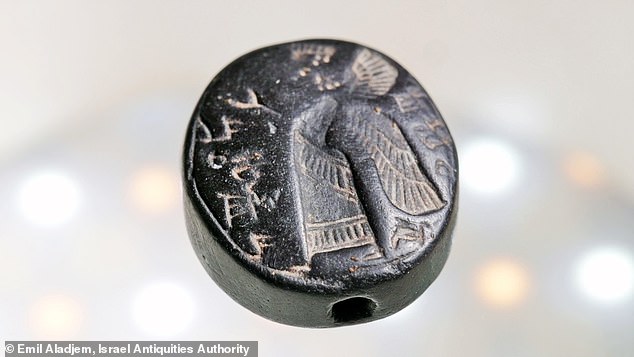Existence of another figure from the Bible may have just been proven – after discovery of ‘genie’ stone
An ancient stone seal has been discovered in Jerusalem that may be linked to a warrior mentioned in the Bible.
The dime-sized black relic was probably worn around the neck as an amulet by a man holding a high position in the holy city 2,700 years ago.
Stone seals were used as a kind of ancient identity card. This one bears an engraving of a winged “genius” or “demon” never before seen in Israel.
Also engraved on the seal are two names: ‘Yeho’ezer’ and ‘Hosh’ayahu’. Both of these are mentioned in the Bible. ‘Yo’ezer’, the abbreviated form of Yeho’ezer, was the name of one of the warriors of King David, the king of Israel at that time.
Archaeologists discovered an ancient stone seal in Jerusalem
And the name Hoshʼayahu is a parallel form of the name ʼAzariah ben Hoshʼaya,’ which is mentioned in the book of Jeremiah.
“It is not impossible that it was Yehoʼezer himself who engraved the names on the object,” research partner Ronny Reich of the University of Haifa said in a press release.
This finding also provides new evidence for the existence of a multinational culture that flourished in ancient Jerusalem, as described in the Bible.
During the First Temple period, when this seal was made, Jerusalem was subject to the Assyrian Empire.
The artistic and cultural influence of this ruling power is reflected in the seal, as it features an engraving of a winged protective figure.
According to the press release, figures of winged demons are known from Neo-Assyrian art from the 9th to 7th centuries BC.
The fact that the seal’s original owner chose a demon as his personal insignia “may reflect his sense of belonging to the broader cultural context,” said excavation leader Yuval Baruch.
But the two names carved on either side of this statue are written in Hebrew script, suggesting that whoever carved them was holding on to his local identity, Baruch said.
“This is an extremely rare and unusual discovery,” said IAA archaeologist and Assyriologist Filip Vukosavovic, who studied the seal.
This seal “opens for us a new window into the days of the Kingdom of Judah during the First Temple period and testifies to the international connections of that administration,” said Israel’s Minister of Heritage, Rabbi Amichai Eliyahu.

The seal, which is about the size of a dime, contains inscriptions that prove that a multinational culture prevailed in ancient Jerusalem, as described in the Bible.

The seal was discovered near the southern wall of the Temple Mount in City of David National Park.
‘This demonstrates the importance and centrality of Jerusalem already 2,700 years ago.’
Moreover, it provides a clearer picture of the reading and writing skills of the inhabitants of Jerusalem during that period.
Contrary to popular belief, it appears that literacy during this period was not reserved solely for the elite of society.
“People could read and write, at least at a basic level, for the needs of trade,” Baruch said.
The researchers found the seal near the southern wall of the Temple Mount in City of David National Park.
They believe that the seal was worn as an amulet by a man named Hoshʼayahu, who held a high position in the government of the kingdom of Judah.
They based their conclusion on the presence of a hole in the artwork, which probably allowed it to be worn on a cord, and on the high level of artistry required to produce the artwork.
“The seal, made of black stone, is one of the most beautiful ever discovered in excavations in ancient Jerusalem,” the researchers said.
The figure depicted on the seal is walking to the right, raising one arm forward with an open palm, “perhaps to indicate he is holding an object,” the press release said.

The researchers believe the relic originally belonged to a man named Hoshʼayahu. When he died, his son Yehoʼezer carved their names into the seal.
On either side of the figure is an inscription in Paleo-Hebrew script. It reads: ‘LeYehoʼezer ben Hoshʼayahu.’
The name Yehoʼezer appears in the Bible in the abbreviated form Yoʼezer. He was one of King David’s warriors.
And in the Book of Jeremiah, which describes the period when the seal was made, the name Hoshʼayahu appears in a parallel form: Azariah ben Hoshʼaya.
The two parts of the biblical first name are written in reverse order of the seal owner’s name, the researchers explain. The second name is the same, but appears in abbreviated form on the seal.
The spelling in these biblical texts therefore matches the name on the newly discovered seal. This is further evidence that the seal was written during the First Temple period.
While the winged figure appears to have been carefully engraved, the engraving of the names was “done in a sloppy manner,” said research partner Ronny Reich, a professor at the University of Haifa.
This supports the researchers’ theory that after Hosh’ayahu’s death, his son Yeho’ezer inherited the seal and carved his name and his father’s name on either side of the demon.
“This unique find is one of numerous archaeological discoveries in the City of David, the historic site of biblical Jerusalem, that confirm Jerusalem’s biblical heritage,” Ze’ev Orenstein, director of international affairs at the City of David Foundation, told Fox News Digital.
“It is also a confirmation of the thousands of years of ties that anchor the Jewish people in Jerusalem – not only as a matter of faith, but as a fact.”
